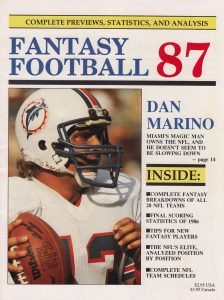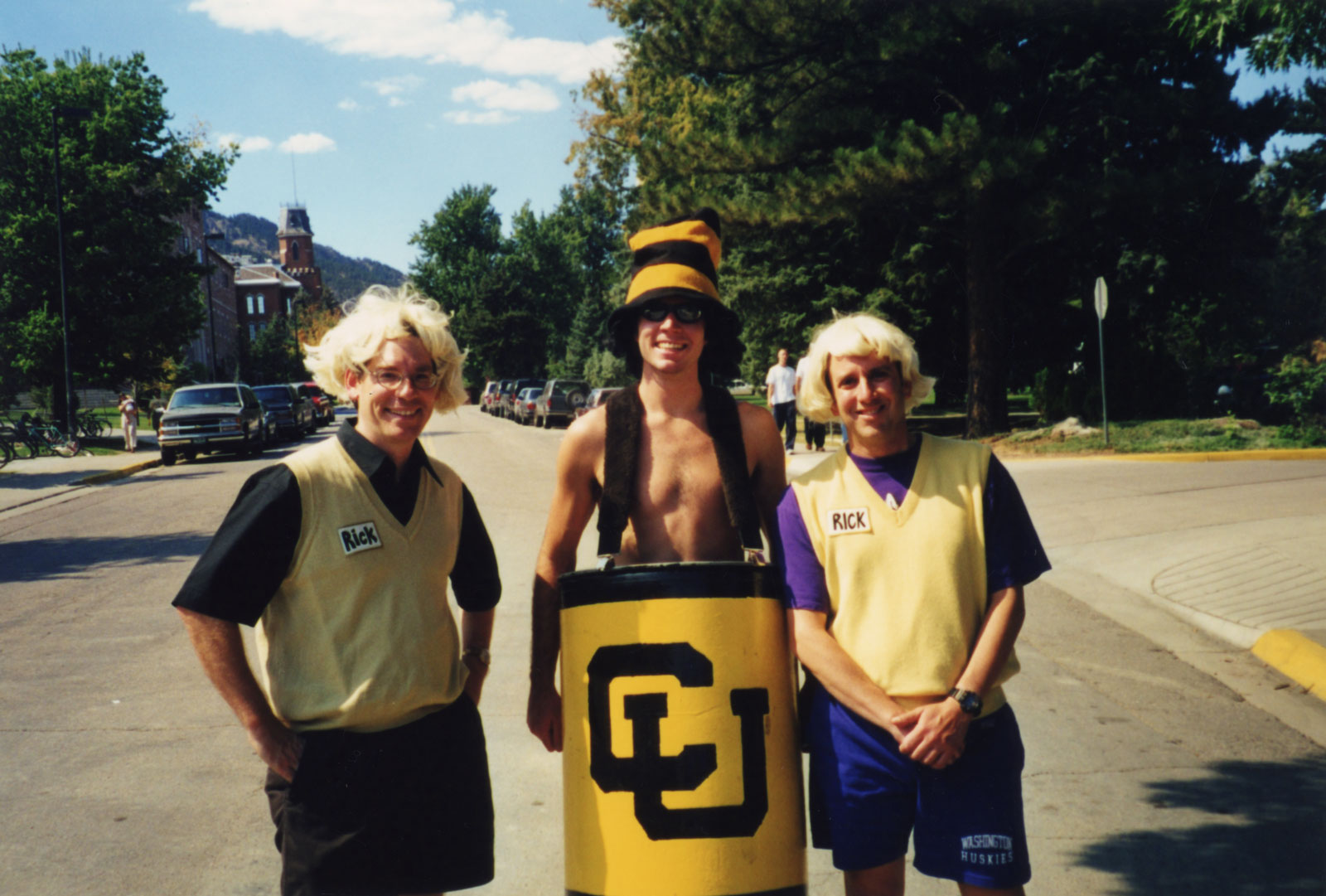Bruce Taylor, ’88, beloved former editor of The Daily, dies at age 59
Bruce Taylor is remembered for his kindness, his wit and his zest for life.

This enduring image of Bruce Taylor celebrating during the 1992 Rose Bowl graced the cover of the program for his memorial service in July. Photo courtesy of Stuart Eskenazi.
He crossed the intimidating threshold known as the front door of the University of Washington Daily newsroom in Fall 1984, a skinny sophomore dorm geek sporting Coke bottle glasses and the wrong style of jeans. Within the four walls of 132 Communications, stained with graffiti questioning all levels of authority, the news editor tasked him with the assignment to cover student government meetings, which to Bruce Taylor must have seemed like a score.
The smart alecks who composed the veteran core of The Daily staff—and regarded ASUW story assignments as reprimands—slotted Bruce right away as exceptionally earnest and talented enough to handle the compulsory (albeit boring) journalism they endeavored to avoid.
Could this unobtrusive strait-laced kid from Spokane’s South Hill survive and thrive within this snark-infested clique of oddballs and subversives? The answer, it turned out, was as plain as the shirt on his back—a Mr. Bubble T-shirt he had obtained by mailing in product box tops. Smart and sardonic, funny and fun-seeking, he would fit in just fine.

Bruce Taylor, left, and Ian Allan, ’86, at a Fantasy Sports Trade Association convention in Minneapolis in 2018. Photo courtesy of Ian Allan.
Bruce Taylor, ’88 (Communications and Political Science), my best friend for 40 years, a guy I first met inside The Daily newsroom, died suddenly in Provence, France, on June 4. The tragic accident occurred 16 days shy of his 60th birthday, 17 days before a planned blowout that was to bring together countless of his friends and family to celebrate with him.
Instead, some 450 of us gathered at Club Husky behind the south stands of Husky Stadium on July 26 for a celebration of life.
Bruce had many friends, with several claiming him as their best. “Some people look to connect rather than reject, and Bruce was one of those people,” said our friend Rebecca Gleason, ’85, who also met Bruce through The Daily. “He went into meeting somebody looking for areas of connection, even from a young age.”
Bruce never let alcohol touch his lips, at no time ever smoked and absolutely despised drugs, which (it may not surprise you) might well have limited his social interactions at The Daily. To the contrary, his dry wit and relentless pursuit of good clean fun uplifted Bruce to one of the gang, even as he refrained from illicit gang activities.
Skip Card, ’86, who first met Bruce as neighbors in McMahon Hall, deserves credit for introducing Bruce to The Daily. Later, during his term as editor-in-chief in fall 1985, Skip named Bruce his arts editor (Bruce named his weekly Friday section “Concrete Block,” after McMahon Hall), ushering in, as Skip recalls, “a Spokane common-man sensibility to arts coverage. Bruce despised Rolling Stone magazine because it turned up its nose at what he called ‘the people’s music.’ A college newspaper was expected to write arts with a focus on the obscure, rejecting anything that might be popular. Bruce, though, wrote and ran stories about the stuff I loved and most of my friends loved. And I loved him for it.”
Held in high esteem among The Daily staff, Bruce rose through the ranks, becoming editor-in-chief in fall 1986. On the first day of his term, Bruce pulled off the most brilliant Daily hoax of all time, publishing on the cover a fake campus map that sent students scurrying to the wrong lecture halls on the first day of classes. The freshman prank earned coverage on the KOMO-TV nightly news, where Bruce coolly shrugged off the outrage: “It’s for their own good. We’re just trying to teach them that they can’t believe everything they read.”

The original issue of Fantasy Football Index, conceived by Bruce Taylor in 1987, launched a successful business partnership that lasted 36 years.
Bruce possessed a healthy curiosity about people. If he found you interesting, he would chat you up. That sense of wonder—combined with a total lack of pretense or pre-judgment—guided him effortlessly into the next phase of his creative life. While still a student, he and his Daily buddy Ian Allan, ’86, co-founded and published Fantasy Football Index, the first magazine in the country devoted expressly to the then-nascent hobby of fantasy football.
Bruce and Ian had started playing fantasy football during the 1986 NFL season, launching The Daily Football League, of which I am a proud senior member. We all lost out last season to Bruce, whose Spokane Pandas— finally!—won the Krohn Bowl, the DFL championship game named in tribute to longtime Daily publisher Barbara Krohn, ’47.
In the spring quarter of 1987, Bruce took Creativity and Innovation, a two-credit chemical engineering course taught by Professor Graham Allan, Ian’s father. Focused on getting inventions off the ground, the class required each student to come up with an idea and then take one step toward making it a reality. Bruce’s idea was to publish a magazine that analyzed NFL player performances to project not how they might help their own team, but rather a reader’s fantasy football franchise.
Bruce looked to his network of Daily friends to help with the new magazine, pulling in Ian as the main writer and then tapping other pals who could connect them to experts in the unfamiliar domains of desktop publishing, printing and distribution. With Bruce getting up to speed on business matters and Ian developing his writing chops, the pair published the first magazine in the summer of 1987, featuring former Miami Dolphins quarterback Dan Marino on the cover.
As the magazine grew in stature, Bruce continued to call on his Daily friends to write columns, design the magazine and work in the office. Daily alum Michelle Byrd, ’88, who loved Bruce like a little brother, remembers arriving home to her Fremont apartment one summer day in 1988 to a surprise. Deadline looming, Bruce had finagled his way inside her place and spread layout pages for the entire magazine across her dining table and every inch of living room floor. “He said something like, ‘Don’t step on that! Don’t move that!’ and I fled before I tripped on something.”
For 36 years, the partnership of Bruce and Ian published Fantasy Football Index in print and eventually also online to an intensely loyal readership.

Bruce Taylor, left, and Stuart Eskenazi dress up as then-Head Football Coach Rick Neuheisel to goad University of Colorado fans at an away game in Boulder in 1999. Photo courtesy of Stuart Eskenazi.
“While I took on the writing, Bruce took on almost everything else,” Ian explains. “Whenever a problem came up—and there were many—he either figured it out himself or found someone who could. He was self-taught in nearly everything he did: desktop publishing, databases, network systems, even guitar. His intellect was quiet, creative and deeply resourceful.”
At the magazine office in the basement of his Laurelhurst home, Bruce made personal connections with readers, fielding their telephone calls to fill orders and answer questions. Sure, readers could have taken care of their business more conveniently online. Instead, they made any excuse to have another delightful interaction with Bruce Taylor.
Bruce sold his share of the publication in 2023 to enjoy what, by all rights, should have been a long retirement. His fatal accident occurred during one of several international trips he had planned now that he was free from the pressures of running a business.
During his memorial inside Club Husky, the Husky Alumni Band serenaded us with spirited renditions of “Bow Down to Washington,” “Louie Louie” and “Tequila.” I felt hopelessly lost, searching for Bruce to share in the love of our alma mater as we had for 40 years.
Bruce Taylor is survived by his wife Ngaire, son Charlie (Aurora), daughter Frances, other family members, many friends, and countless admirers.
Stuart Eskenazi, ’85, worked 25 years as a reporter for several newspapers, including the Seattle Times, Tacoma News Tribune and Tri-City Herald. Now an independent writer, editor and strategic communications consultant, he can be contacted at stuart@semessaging.com.